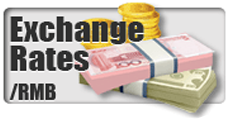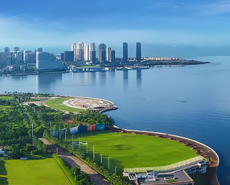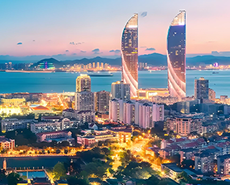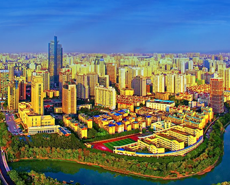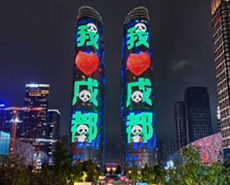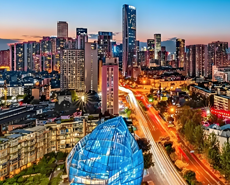
Jiangxi Tungsten sets for fast-track development after restructuring
----Interview with Lian Hongmei
General Manager
China National Nonferrous Metals Imp. & Exp. Jiangxi Corporation Limited
General Manager
China National Nonferrous Metals Imp. & Exp. Jiangxi Corporation Limited
The company was first set up in March 1985 as a subsidiary of China National Nonferrous Metals Imp. & Exp. Corporation in Jiangxi province, and was renamed China National Nonferrous Metals Imp. & Exp. Jiangxi Corporation Limited in September 2008 after the state-owned enterprise reform. As a provincial-level foreign trade company with importing and exporting right, it has a registration capital of RMB80 million and is engaged in industrial production, technology development and foreign trade. It was the first company of its kind in Jiangxi province passing ISO9001 (2000 version) certification and now is a member of Jiangxi Tungsten Holding Group Co., Ltd., serving as the foreign trade channel of its mother company.
AM: As we have known, Jiangxi Tungsten Holding Group Co., Ltd. has completed its restructuring recently. And would you please give a brief introduction to your company?
Ms. Lian: To restructure Jiangxi province’s tungsten and rare metals industries is a significant move adopted by Jiangxi provincial government to push ahead the reform on state-owned enterprises, optimize industrial structure of Jiangxi’s tungsten and rare metals industries, and to increase strengths of the above industries. On April 8, 2016, Jiangxi provincial government formally launched the restructuring and merger process of its tungsten and rare metal industries. Before that, Jiangxi Tungsten Holding Group Co., Ltd. had three major businesses, the former Jiangxi Tungsten Holding, Jiangxi Tungsten Group, and Jiangxi Tungsten Co., Ltd.


In January, 2017, upon completion of the restructuring, our group company was renamed as Jiangxi Tungsten Holding Group Co., Ltd. At present, the group company has 117 fully-owned subsidiaries and 24 partly-holding companies, and 4 metal business areas (tungsten, rare earth, tantalum-niobium, and copper-cobalt-nickel-molybdenum-tin) and three non-metal business areas (equipment manufacturing, trading, science and technology on health and age-care service). As for tungsten products, we have the most complete industrial chain consisting of 13 tungsten mines, 5 smelting plants, 2 tungsten powder plants, 1 cemented alloy plant and 1 hard-surface material plant. Thanks to the restructuring, the overall strength of our group company has been improved and inter-subsidiary complementarity strengthened. Of course, we have to further optimize subsidiaries’ businesses, some of which may be shut down and some need to be further strengthened.
On the other hand, during the first half of this year, our group company also began to reshuffle headquarter departments and to downsize the staff. All staff members had to go through strict competition in order to be re-employed. As a result, the number of headquarter departments dropped by 50.2% from the previous 31 to the current 16 and number of headquarter staff members was slashed by 51% from the previous 173 to 86. In this August, the former Jiangxi Tungsten Holding, Jiangxi Tungsten Imp. & Exp. and Sales Branch also undertook a merger operation to form the current China National Nonferrous Metals Imp. & Exp. Jiangxi Corporation Limited (“Jiangxi Corporation Limited”). Similarly, the numbers of its administrative officers and staff were slashed by nearly 50%. Now Jiangxi Corporation Limited has four business departments and two comprehensive departments. The four business departments are respectively in charge of tungsten products (including tungsten products and cemented alloys), ferroalloys and minor metals, rare earth and tantalum-niobium, and copper-cobalt-nickel and structural trade. And the two comprehensive departments are risk-management & comprehensive business department and the general office.
AM: During August, prices in the tungsten market rose quickly, and after that prices in the domestic market fell back. How do you think of this round of price adjustment? What is the price trend in the fourth quarter?
Ms. Lian: The rapid price rise in August was beyond our expectation, and we think it has been a rarely seen phenomenon over the past ten years in the tungsten market. During August, the quotation from our group company for wolframite 65%min was RMB91,500/t (USD13,784/t), while in September our quotation moved up to RMB121,000/t (USD18,228/t), up by over 30% within one month. Regarding reasons for the round of price increases, if we view from the whole industry, we find that prices for basic metals such as copper, lead, zinc and aluminum had been holding at a high level since last year and this trend lasted into 2017. So they served as a booster for prices of minor metals and insiders believed that prices for minor metal would go up this year. Just as expected, during the first half of this year market conditions for minor metals were favorable. Viewing from the financial side, a lot of investment capitals flowed into the strategic metal market as investors felt optimistic about this market.
And the third factor we need to consider is the supply-demand relation. Regarding supply, let’s first talk about stocks. Since the latter half of 2013 prices for tungsten products fell back from a high level and the price adjustment process lasted for four years, during which many producers tried to sell their stocks in the market or just consumed by themselves. And similarly in the overseas market, major plants also tried to consume their stocks previously purchased at high levels. By 2017, there was a notable decrease in the volume of stocks available in the market. As for production, with environmental protection policy becoming stricter, unqualified mines and smelting plants were forced to cut output or shut down. Some private mines felt that it was profitless and therefore difficult for them to resume production as prices had been low over the past years and their production costs were high. As a result, those mines witnessed a larger decline in capacity. In addition, most large-sized tungsten mines belong to several major tungsten groups and there are no great quantities of tungsten ores available in the market. All these had certain impacts upon outputs of tungsten products in the market. Now let’s talk about the demand. The American and European economies recover, which was reflected from China’s export data in the first half of this year. China’s exports of tungsten products increased by 47% YOY to reach the level in 2007. Meanwhile, we feel that some overseas consumers intend to build necessary stocks. At the same time, as far as we know, most Chinese cemented alloy producers have maintained full production schedule until November, which shows that the demand in domestic market is also strong. In addition, some large-sized tungsten plants also increased purchases in the spot market. For the above reasons, prices in the tungsten market soared in August; and during the process, some private enterprises tried to replenish their stocks, which also helped boosting up the prices.
In the previous years, prices for tungsten concentrate held at RMB50,000-60,000/t (USD7,528-9,031/t), which were far below our mining costs of RMB80,000-90,000/t (USD12,041-13,547/t), let alone below the value of tungsten itself. We think that it is rational for prices to increase to RMB110,000-120,000/t (USD16,557-18,062/t). Since September, prices began to fall back to some extent, as expected. Anyway, prices in the tungsten market had been moving up too quickly within a short period of time and a moderate adjustment is necessary to make sure that the market runs healthily. By late September, prices for wolframite 65%min had dropped to RMB113,000-115,000/t (USD17,009-17,310/t), down by 5-6% from the highest level during the upward process. Compared with the price rise of nearly 40%, we think that the decrease was rational.
As for prices in the fourth quarter, we believe that they would remain stable on the whole and might go up to some extent. After the above round of price adjustment, market players have gradually accepted the current prices and traders are waiting for opportunities to replenish their stocks. Besides, during the recent prices upticks, overseas customers refused to accept the increased prices and made rare purchases; especially when APT prices moved up to over RMB180,000/t (USD27,093/t), there was a notable decrease in overseas purchases. So now the prices have dropped to some extent and overseas customers may gradually enter the market to make purchases. We believe that prices in the fourth quarter will remain stable on the whole and may edge up too, and prices for tungsten concentrate may fluctuate within the range of RMB114,000-130,000/t (USD17,159-19,567/t).
AM: Recently, the RMB-USD exchange rate has been fluctuating frequently and spot transactions were limited. Do they have any impacts upon your exports of APT and ferrotungsten in comparison to those in the same period of last year?
Ms. Lian: During the first half of 2017, the Chinese currency kept appreciating, which was unfavorable to our exports. But price upticks for tungsten products partly offset impacts from the exchange rate. Now the RMB-USD exchange rate falls back and this would be good news for our export business in the future. Our APT exports increased by around 40% MOM and ferrotungsten exports by around 23% YOY. We exported around 1,103t of ferrotungsten from January to July 2017, in comparison to around 895t exported in the same period of last year. From January to July of this year, our exports of various tungsten products including cemented alloys exceeded 2,000t. We can say that the growth in our exports is a mirror of that in China’s total exports in the first half of 2017.
AM: At present, ferrotungsten outputs around the world are limited, and so how do you think of the development trend in the global ferrotungsten market this year?
Ms. Lian: Since 2002 when we commenced ferrotungsten production, fifteen years have passed and we get to know better the ferrotungsten market. Ferrotungsten producers show quite great dependence upon raw materials, and so only when they have stable supply of raw materials can they stand firm in the market. Before we built our own ferrotungsten plant, ferrotungsten in the market was mainly supplied by SCIG Emei Ferroalloy Group and Sinosteel Jilin Ferroalloy. At that time, the tungsten concentrate they used were supplied by our group company. Later, we built our own ferrotungsten plant and thus reduced our supply of raw material to them. Besides, they could not purchase large quantities of tungsten concentrate outside of our company. This was one of the reasons why the two companies exited the ferrotungsten market. From this case we can see that, without stable and sufficient supply of raw materials, it would be difficult for ferrotungsten enterprises to survive. It’s the same with today’s enterprises. At present, supply of high-quality wolframite keeps dwindling in the spot market, and few private producers are willing to process raw ores to the 65%min material, instead, only around 50%, as the rate of return of processing high-grade tungsten concentrate is low. To produce high-quality ferrotungsten, a certain portion of high-grade wolframite is a must in the production process, and so the accessibility to wolframite determines the status of ferrotungsten enterprises in the industry, no matter for Chinese or foreign enterprises. The main reason why our group company can remain a major player in the ferrotungsten industry for years is that we have our own tungsten mines, of which 7 or 8 produce wolframite and therefore guarantee stable supply to the mother company.
In Russia, there are two major ferrotungsten producers and their production also depends upon supply of tungsten ores and wastes from their own country. In 2016, they purchased certain quantities of low-priced tungsten concentrate from their government, and therefore they were able to sell ferrotungsten in the European market at prices lower than normal prices or even lower than normal production costs. This had imposed some impacts upon us. But this year in the tungsten market, with low-priced tungsten concentrate stocks gradually consumed and prices rising, plus improving demand for APT and other tungsten products, it becomes difficult for Russian ferrotungsten producers to purchase sufficient high-quality tungsten concentrate at low prices. Therefore, Russian producers have no notable advantages in price competition this year.


